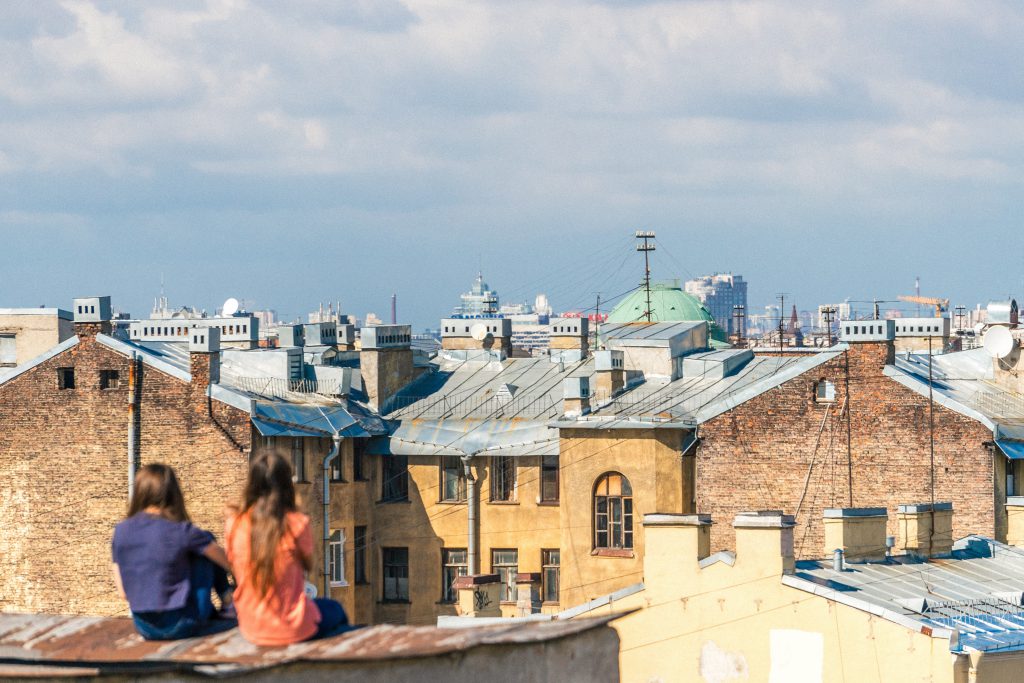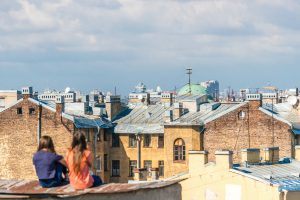St. Petersburg, Capital of the Nineteenth Century

“Burkov House is the whole of Petersburg.” Alexei Remizov
The protagonist of Sisters of the Cross, Marakulin, falls on hard times and leaves his nice apartment in the Burkov House to move into a rented room three floors up. This change in circumstances gives him a new perspective on the city. Whereas before his window looked onto a neighborly courtyard where children play, he now sees the factory and hospital behind the building. Now that his apartment faces out toward the larger world, Marakulin is exposed to the city’s noise—“that wearisome sound of iron hitting against stone as Petersburg… rebuilds itself,” to extreme heat in summer, and to black soot that accumulates between his windowpanes.

Marakulin’s window offers a prime view of the city’s rapid industrialization. He quickly becomes accustomed to his new surroundings. He cannot see the sky, but the electric floodlight in the factory yard shines “like a moon through the mist and smoke.” A light in a hospital window at night replaces the stars. The seasons are defined by the ecology of coal: when more fuel is brought into the factory and “day after day the yard grows into a black mountain, this means that summer has come to an end… When, however, the huge mountain begins to diminish, melting and slipping away like snow,” it is spring.

Burkov House’s different faces reveal the strikingly different life-worlds contained within St. Petersburg’s dense fabric. The apartment complex is located in a central part of the city, near major cathedrals and the historic theaters on the Nevsky Prospekt, St. Petersburg’s main boulevard (The Fontanka River, on which the Burkov House is located, is perpendicular to the Nevsky Prospekt.) The tenement’s main frontage houses aristocrats, high government officials, a German doctor, and other wealthy urbanites who occupy multiple apartments each. The farther end of the courtyard is reserved for the middle class. Marakulin’s new room is probably on the undesirable side of the building, where the residential block abuts the hospital and the industrial complex.
Thus, all aspects of the turn-of-the-century urban experience are present in Marakulin’s immediate vicinity: poverty, misfortune (perhaps most extreme for those confined within the Obukhov Hospital’s psychiatric ward), extreme wealth, rapid industrialization infringing on the city’s eighteenth-century core, broad avenues, quiet courtyards sheltered from the street, and soot-covered corners in back alleys. As Roger Keys writes in the introduction to Sisters of the Cross, Burkov House and its surroundings are real places. But they are also a microcosm of St. Petersburg’s particular modernity.

While the rise of the industrial metropolis was an international phenomenon at the turn of the twentieth century, Petersburg’s growth was particularly rapid and tumultuous. As Mark D. Steinberg writes in Petersburg Fin de Siècle, from its creation in 1703, St. Petersburg experienced a continuous rise in its population, reaching almost one and a half million circa 1900. The construction noise Marakulin hears every summer is a sign of the breakneck pace of development. Growth continued in spite of high mortality as more and more people streamed into the metropolis. New monumental buildings, avenues, parks and embankments embellished the tsarist capital, but elegant facades often concealed cramped quarters. Industry took up any usable space, including in the historic core.

While many of these experiences have their counterparts in Paris, Berlin and elsewhere, what may be particular about St. Petersburg is the diversity of its inhabitants and the relative lack of segregation within the city. Steinberg attributes this phenomenon to an inadequate public transit system at the time, which compelled everyone to live as near as possible to their place of work. In the worst cases people unable to afford a room rented “corners,” like the old man Gvozdev who appears out of nowhere in Marakulin’s apartment at the beginning of the book. In contrast to gentrifying cities today, people in Gvozdev’s position would live on the same block as the haute bourgeoisie and aristocracy at the front end of the Burkov House.

It is under these conditions that Marakulin, displaced and disgraced, finds himself seemingly at the center of life in St. Petersburg and meets people of all walks of life. Encounters that would be highly unlikely today happen in the Burkov House, where “the whole of Petersburg” lives on one city block.
1 Mark D. Steinberg, Petersburg Fin de Siecle (New Haven: Yale University Press, 2011), pp. 10-12.
Ani Kodzhabasheva is a Ph.D. candidate studying architectural history and comparative literature at Columbia University.
Remember to enter our book giveaway for a chance to win a free copy of Sisters of the Cross!








